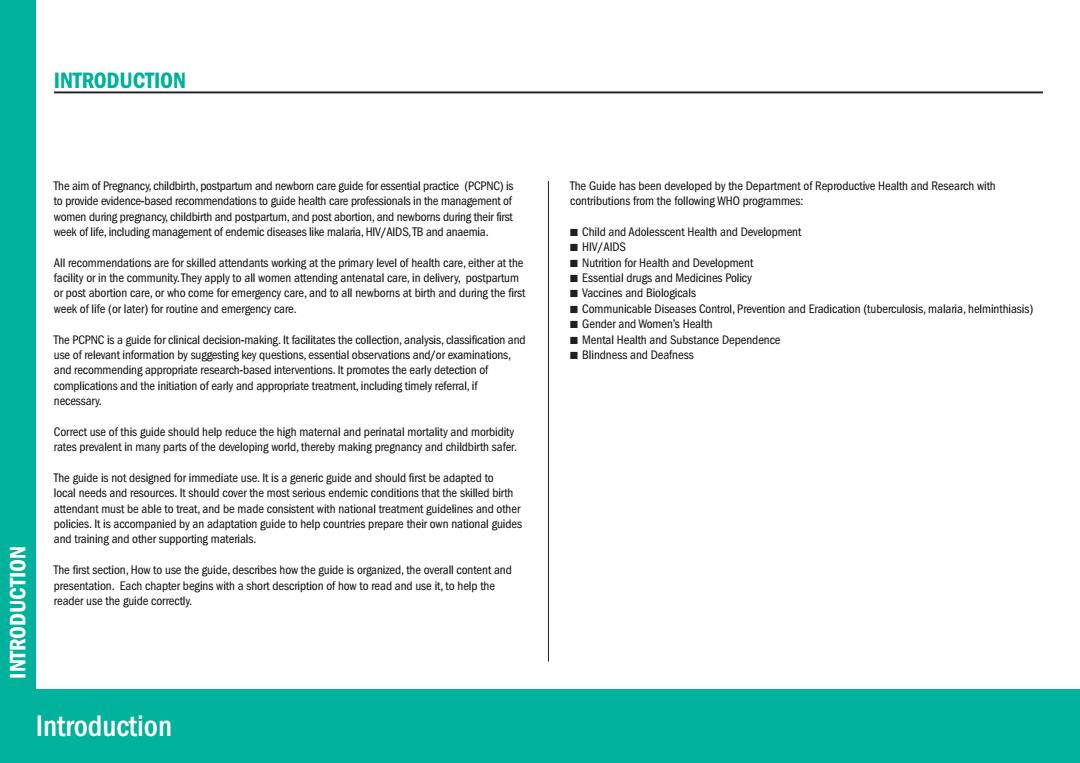正在加载图片...

INTRODUCTION The aim of Pregnancy,childbirth,postpartum and newborn care guide for essential practice (PCPNC)is The Guide has been developed by the Department of Reproductive Health and Research with to provide evidence-based recommendations to guide health care professionals in the management of contributions from the following WHO programmes: women during pregnancy,childbirth and postpartum,and post abortion,and newboms during their first week of life,including management of endemic diseases like malaria,HIV/AIDS,TB and anaemia. Child and Adolesscent Health and Development ■HV/AIDS All recommendations are for skilled attendants working at the primary level of health care,either at the Nutrition for Health and Development facility or in the community.They apply to all women attending antenatal care,in delivery,postpartum Essential drugs and Medicines Policy or post abortion care,or who come for emergency care,and to all newbomns at birth and during the first Vaccines and Biologicals week of life (or later)for routine and emergency care. Communicable Diseases Control.Prevention and Eradication(tuberculosis.malaria.helminthiasis) Gender and Women's Health The PCPNC is a guide for clinical decision-making.It facilitates the collection,analysis,classification and Mental Health and Substance Dependence use of relevant information by suggesting key questions,essential observations and/or examinations, Blindness and Deafness and recommending appropriate research-based interventions.It promotes the early detection of complications and the initiation of early and appropriate treatment,including timely referral,if necessary. Correct use of this guide should help reduce the high maternal and perinatal mortality and morbidity rates prevalent in many parts of the developing world,thereby making pregnancy and childbirth safer. The guide is not designed for immediate use.It is a generic guide and should first be adapted to local needs and resources.It should cover the most serious endemic conditions that the skilled birth attendant must be able to treat,and be made consistent with national treatment guidelines and other policies.It is accompanied by an adaptation guide to help countries prepare their own national guides and training and other supporting materials NOILO The first section,How to use the guide,describes how the guide is organized,the overall content and presentation.Each chapter begins with a short description of how to read and use it,to help the reader use the guide correctly. IntroductionThe aim of Pregnancy, childbirth, postpartum and newborn care guide for essential practice (PCPNC) is to provide evidence-based recommendations to guide health care professionals in the management of women during pregnancy, childbirth and postpartum, and post abortion, and newborns during their first week of life, including management of endemic diseases like malaria, HIV/AIDS, TB and anaemia. All recommendations are for skilled attendants working at the primary level of health care, either at the facility or in the community. They apply to all women attending antenatal care, in delivery, postpartum or post abortion care, or who come for emergency care, and to all newborns at birth and during the first week of life (or later) for routine and emergency care. The PCPNC is a guide for clinical decision-making. It facilitates the collection, analysis, classification and use of relevant information by suggesting key questions, essential observations and/or examinations, and recommending appropriate research-based interventions. It promotes the early detection of complications and the initiation of early and appropriate treatment, including timely referral, if necessary. Correct use of this guide should help reduce the high maternal and perinatal mortality and morbidity rates prevalent in many parts of the developing world, thereby making pregnancy and childbirth safer. The guide is not designed for immediate use. It is a generic guide and should first be adapted to local needs and resources. It should cover the most serious endemic conditions that the skilled birth attendant must be able to treat, and be made consistent with national treatment guidelines and other policies. It is accompanied by an adaptation guide to help countries prepare their own national guides and training and other supporting materials. The first section, How to use the guide, describes how the guide is organized, the overall content and presentation. Each chapter begins with a short description of how to read and use it, to help the reader use the guide correctly. The Guide has been developed by the Department of Reproductive Health and Research with contributions from the following WHO programmes: N Child and Adolesscent Health and Development N HIV/AIDS N Nutrition for Health and Development N Essential drugs and Medicines Policy N Vaccines and Biologicals N Communicable Diseases Control, Prevention and Eradication (tuberculosis, malaria, helminthiasis) N Gender and Women’s Health N Mental Health and Substance Dependence N Blindness and Deafness INTRODUCTION INTRODUCTION Introduction